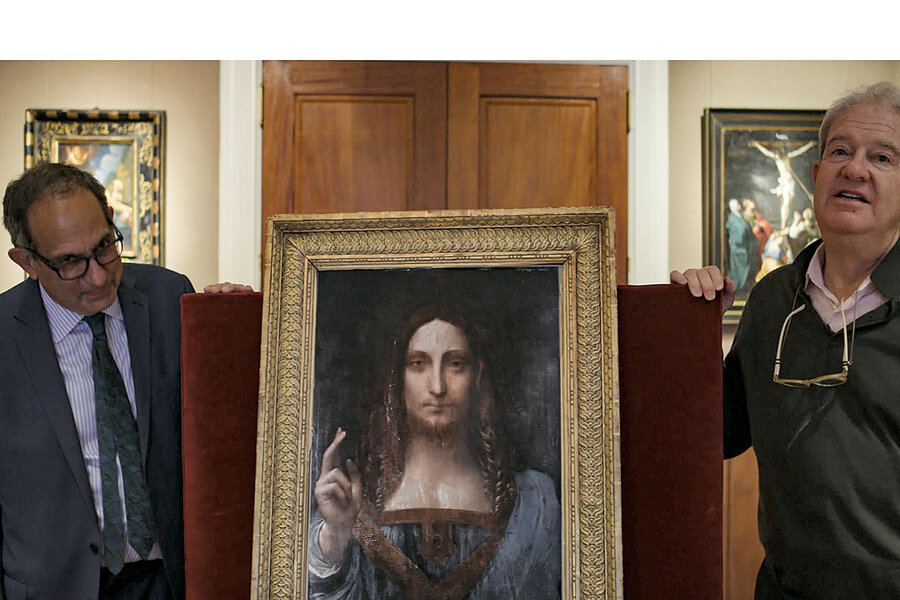‘The Lost Leonardo’ pulls back the curtain on greed in the art world
Loading...
The infamous “Salvator Mundi” painting is the focus of the fascinating documentary “The Lost Leonardo,” a movie that scrutinizes the often corrupt crossroads of art and commerce.
The oil painting – the title is Latin for “Savior of the World” – was unceremoniously discovered in 2005 in a nondescript New Orleans auction house by a pair of art dealers, who bought it for $1,175. It depicts Jesus Christ making the sign of the cross in his right hand and holding a transparent crystal orb in his left. The dealers conjectured they had stumbled upon a “sleeper” – a painting worth a great deal more than originally thought. Could this be the famous Leonardo painting supposedly lost to history rather than just another extant copy by one of his students or followers?
Ultimately, in 2017 at a Christie’s auction in New York, it racked up the highest sale of any artwork in history – $450 million – primarily because, despite much contention among art experts, many chose to believe it was indeed a true Leonardo. The mysterious buyer turned out to be Saudi Crown Prince Mohammed bin Salman, later implicated in the killing of journalist Jamal Khashoggi. Its previous owner was a Russian billionaire oligarch with connections to a Swiss financier who kept the painting locked, tax-free, in a Geneva vault.
Why We Wrote This
Is owning art about the art, or the pursuit of the highest bidder? Film critic Peter Rainer says the new documentary “The Lost Leonardo” is fascinating in its unraveling of a mystery – and the power of a flush bank account.
The director, Andreas Koefoed, lucidly lays out how the “Salvator Mundi” achieved its outsize reputation. What soon becomes clear is that we are watching a case history of the politics of greed. On some level, it didn’t even matter that the painting might not be a real Leonardo. What attracted museumgoers and curators and buyers was its fabulous renown.
Not that there weren’t respected art historians who vouched for the painting’s authenticity, even though in its initial condition it was severely damaged and overpainted. Starting in 2006, Dianne Modestini, a leading authority in New York and a true believer, spent several years restoring it to a presentable state. Two years later, London’s National Gallery convened a series of global experts to carefully inspect it and, although the verdict was at best cautiously favorable, the gallery nevertheless controversially included it in a blockbuster Leonardo exhibition in 2011.
Still, no museum was willing to buy the painting, perhaps because there were too many unanswered questions surrounding it. The painting’s provenance – its history of ownership dating back to the Renaissance – was too murky.
And then there were the naysayers, who derided the painting as not even good art, let alone a Leonardo. Art critic Jerry Saltz, one of the most vocal deriders in the film, calls it “a made-up piece of junk.” Modestini’s extensive restorations were thought to constitute as much as 90% of the final portrait. And yet Christie’s, dubbing it “the male Mona Lisa,” staged sold-out pre-auction showings in high-end markets like Hong Kong, London, San Francisco, and New York, and engineered a superslick ad campaign featuring people, including Leonardo DiCaprio, oohing and aahing the image.
We are made privy to an ecosystem in which art is employed as collateral, a tradable commodity, perhaps even, as investigated by the FBI’s Art Crime Team, a way to launder money. The documentary also depicts the ways regimes like Saudi Arabia use famous artworks to achieve instant cultural cachet on the world stage.
And what of the artwork itself? After a dust-up between the Saudi crown prince and the Louvre in 2018 ended any prospect of a museum showing, no one knows where the “Salvator Mundi” currently resides – a free port Swiss vault or the crown prince’s yacht are the likeliest candidates. So the painting cannot be viewed by the very people who might best appreciate it. As this film amply demonstrates, in the highest realms of commerce, wielding power is paramount.
And yet, what stayed with me after I left the movie was a reaffirmation of how great art, in all its many manifestations, has the power to move us and change our way of seeing, even our lives. If I could issue a plea, it would be this: Honor the artist, not the price tag.
Peter Rainer is the Monitor’s film critic. “The Lost Leonardo” is available in select theaters starting Aug. 13. It is rated PG-13 for images of art containing nudity.





